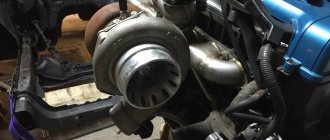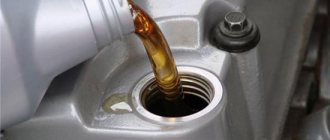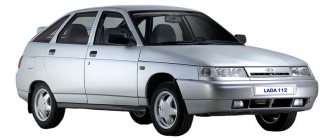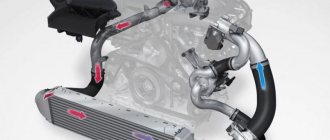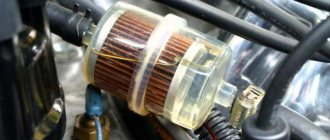Breather in the gearbox: operating principle and features
So, in order to understand what a breather is in a car, it should be noted that in fact it is a valve that allows you to reduce the pressure in the crankcase of a sealed unit (engine, gearbox, etc.) A breather, breather or breathing valve is a device through which the container communicates with the atmosphere, and even taking into account the temperature difference in the container, it is possible to maintain atmospheric pressure.
On the one hand, such a valve allows you to relieve excess pressure (equalize the pressure during heating and cooling), and on the other hand, it does not allow oil to leak out of the unit or unit. Also, when cooling, dirt, moisture and dust are not drawn into the unit or assembly. For this reason
engine breather
or box breather is actively used in various cars.
As you know, the gearbox performs the task of converting torque from the engine, after which torque is transmitted to the drive wheels. The box itself is filled with transmission oil, which tends to heat up during operation of the gearbox, expanding in volume. The result is an increase in pressure that needs to be relieved. If this is not done, the pressure in the gearbox will be increased, which will cause oil to leak from the gearbox through the seals, seals and gaskets.
It is not difficult to guess that oil leaks from the gearbox will lead to the lubrication level dropping, the box will begin to work poorly, and will also wear out quickly and actively. First, the driver experiences difficulties and discomfort (gears engage worse), then extraneous noise appears (hum, vibration of the box), then synchronizers, bearings, gears and other gearbox elements fail. In the gearbox, the breather is installed on the gearbox housing cover.
- Let us add that breathers are also installed on the engine (engine breather), on the transfer case, gearboxes, and axles. As for the internal combustion engine, the pressure in the unit grows quite actively, as strong heating occurs, some of the exhaust gases inevitably break into the crankcase, etc. To avoid oil leaks as a result of increased pressure, said pressure is “released” through the breather.
Also in the car design you can find breathers on bridges. The fact is that oil is also filled inside the car axle. In this case, as in the case of gearboxes and internal combustion engines, the internal cavity must have communication with the atmosphere in order to avoid an increase in pressure inside the unit.
Another important function of the box or axle breather, as well as the engine, is protection from dust, dirt, water, etc. This is especially true for car axles, since the bridge is an open element (for example, on an SUV) and can be submerged in water or mud when driving through difficult areas.
Useful tips
As a general rule, you should check all existing breathers on a particular vehicle (engine breather, transmission breather, axle breather, etc.). The fact is that oil particles can be squeezed out through the breather during its operation, which leads to active contamination.
In practice, breathers need to be dismantled and cleaned of dirt and oil residues. If cleaning does not produce results (in the case when oil “presses” out of the gearbox, motor or axle precisely because of a faulty breather), the device must be completely changed.
Also, before cleaning, you need to know how to remove the breather. On many cars, it is enough to remove the rubber cap on top and then clean the valve. Some other models may not have a rubber breather cap, and the breather is located in the 5th gear cover. In this case, cleaning is also carried out using improvised means.
At the same time, we would like to add that the rear axle crankcase breather deserves special attention (on many cars it is installed in the upper part of the rear axle crankcase, closer to the right side). This valve is subject to active contamination. If the breather becomes dirty or stops working for other reasons, oil leaks from the axle due to increased pressure.
In this case, you should start with cleaning. After cleaning, it is recommended to drive 20-30 km. If the leak continues, and there are no other obvious reasons, the rear axle breather needs to be replaced. If oil drips still appear, you should look for a fault not related to the breather.
Easy to fix oil leaks from the gearbox
An attentive driver who cares for the car can quickly detect an oil leak. Measurements are taken of oil droplets on the asphalt surface. The appearance of oil indicates that there is a problem that needs to be solved. Ignoring the problem in the future will cost a lot of time and money.
Oil leaks appear on the surface of the gearbox housing. If you don't look closely, they are hard to notice. As the amount of oil increases, droplets appear.
After parking the car, small black oily puddles form on the asphalt. You need to drive the car onto a viewing hole or lift. It will make it possible to quickly find the location of the leak and fix the problem.
The main easily repairable oil leaks from the gearbox:
Loose nut on transmission oil drain.
A common cause of oil leaks, it can be eliminated in less than 5 minutes. When changing the oil in the gearbox, they were in a hurry and did not act carefully. After a while, a loose nut is discovered. Oil oozes through the drain hole and leaves marks on the road surface.
Vibration increases the leak, as the nut moves away more and allows more oil to pass through. Some unlucky drivers managed to completely pour the oil onto the ground during the day. If you don't notice the problem in time, you can end up with a jammed transmission.
The oil dipstick is not inserted correctly.
Drivers do not pay attention to the correct installation of the oil dipstick in vain. Often causes oil leaks. A skewed dipstick does not close the channel tightly enough. When heated, oil leaks out.
If leaks are found on the gearbox housing, you need to carefully inspect the position of the dipstick. To eliminate the leak, it must be corrected.
Reverse sensor.
It is mounted in the gearbox and causes oil leakage if not tightened sufficiently. The driver’s actions are the same as when the nut on the drain is not tightly tightened. You need to tighten the reverse sensor and all the leaks will stop.
Excessive amount of oil.
Experts say that overfilling the gearbox with oil is much worse than underfilling it. An excess amount of oil fluid creates excess pressure in a confined space.
The sealing elements of the gearbox receive additional stress. They cannot withstand the pressure of oil if they are worn out. Excess oil comes out. The problem can be solved by draining the excess amount.
Leaking through the lid.
The cause of the malfunction is wear of the sealing material. To eliminate oil leaks from the gearbox, change the gasket. If chips and cracks are found, use epoxy resin. Levels any damaged surfaces.
The above reasons can be simply and easily eliminated if they are detected in a timely manner. Does not require material costs.
Replacement
Replacement is carried out in a certain order. This will be discussed below.
Diagnostics
Replacing drive seals on a VAZ 2109, 2108 usually begins with determining the location of the oil leak, the degree of wear and damage to the drive seals. This degree of wear can be determined by oily streaks that appear on the gearbox housing and, during long-term use, look like spots of greasy, non-drying dirt.
Advice! Replacing drive seals on VAZ 2108, 2109 should first begin with checking the breather, since the lack of ventilation in the gearbox is the main reason why oil is squeezed out through the side cuffs by crankcase gases.
Dismantling
Replacing drive seals for VAZ 2109 and VAZ 2108 involves removing the drives and draining the oil from the gearbox , so we will need... Tools:
- Keys for seventeen and thirty (with a long knob);
- Container for drained oil (volume of at least three liters);
- Installation;
- Screwdriver;
- Tools for pressing in a new oil seal (hammer and mandrel)
Of course, in order to press in a new oil seal, you can use the body of the old one, but, believe me, this is not very convenient, so it is advisable to select the necessary mandrel according to the diameter of the oil seal, for example, by taking a suitable piece of pipe for this.
Delivery by transport company
Delivery by one of the transport companies with a representative office in your city. Delivery time: 2-10 days depending on the distance of your locality from Togliatti. The most convenient and fastest way to deliver orders of different sizes. Delivery cost from 250 rub. depending on weight and delivery distance.
Orders are sent by transport companies based on 100% payment for the order.
We cooperate with:
PEC
Find the nearest representative office, track the cargo and calculate the cost of delivery
pecom.ru
Business Line
Find the nearest representative office, track the cargo and calculate the cost of delivery
dellin.ru
Baikal Service
Find the nearest representative office, track the cargo and calculate the cost of delivery
baikalsr.ru
Energy
Find the nearest representative office, track the cargo and calculate the cost of delivery
nrg-tk.ru
GTD (formerly KIT)
Find the nearest representative office, track the cargo and calculate the delivery cost
https://gtdel.com
Zheldor expedition
Find the nearest representative office, track the cargo and calculate the cost of delivery
jde.ru
SDEK
Find the nearest representative office, track the cargo and calculate the cost of delivery
edostavka.ru
If you do not know which method of delivery of goods will be more convenient for you to use, then place an order for any method, and when our manager contacts you to confirm the order, he will recommend you the most optimal method in terms of cost and delivery time for your order. No matter what region of Russia you live in, there is always a profitable and convenient delivery method for you.
The lead time for placing orders with “In Stock” items is 1-4 business days, after receipt of funds (orders are not generated on Saturday and Sunday). Lead time for orders that include painting services: 3-8 business days. The lead time for placing orders and “made to order” items is from 14 days; you can check with the manager for more detailed information.
Delivery is carried out throughout Russia and the CIS. Orders for pickup are placed on the website, the processing time is on average 1-4 business days, after the items arrive at the pickup point, the manager will notify you when you can receive your order.
Attention! Regardless of which delivery method you choose, check the integrity of the goods and packaging upon receipt of the cargo (parcel).
ATTENTION! All fragile goods (headlights, plastic products, glass, etc.), by default, are sent in additional paid packaging from TK. If you take responsibility for integrity, we can ship without it. To do this, you need to make a note in the comments when placing your order. For additional information, please contact the managers.
To improve the quality of customer service, video recording of order packaging is performed.
Computer diagnostics of cars
Thanks to this method, you will be able to identify the reasons that lead to high use of gasoline. Sometimes it is impossible to clearly identify them, but the computer shows the entire condition of the car as a whole, as well as the condition of the main parts that directly affect the fuel consumption of the engine.
If you find an error, please select a piece of text and press Ctrl+Enter.
Didn't find the information you are looking for? on our forum.
In 1999, AvtoVAZ introduced a five-door version of its VAZ-2110 sedan, which received the factory index VAZ-2112. Due to the fact that the length of the body was slightly shortened, the car became more controllable and maneuverable, while the volume of the luggage compartment was increased due to the modified shape of the rear part and amounts to 400 liters. With the rear seats folded down, its volume almost doubles.
Production of the model continued until 2008, after which the VAZ-2112 was replaced in production by the five-door version of the Priora. Four versions of the “twelfth” model were produced, differing in engines and power.
Since 2001, VAZ-2112 cars in the VAZ-21120 version have been equipped with a VAZ-21120 injection 16-valve engine with a volume of 1.5 liters. This engine developed a power of 92 hp.
With. and a torque of 133 Nm and was considered one of the most popular engines in the LADA 110 family. The engine was paired with a 5-speed manual transmission.
What is an engine breather and why is it needed?
Everyone knows that the internal combustion engine, the same one that is installed under the hood of your car, does not run on gasoline, diesel or gas, but on their mixture with air. Moreover, it is air, which costs nothing (unlike fuel, for which we regularly pay a tidy sum at the gas station), that is required many times more. But in addition to the influx of clean air and the removal of exhaust gases through the exhaust pipe, parasitic gases are formed during the operation of the internal combustion engine.
A breather is nothing more than a breathing valve that constantly relieves excess pressure that forms inside the engine during operation. The need for this simple, relatively inexpensive part is difficult to overestimate.
Why is there smoke coming from the breather?
There can be only one malfunction of the breather: it began to poorly pass accumulated gases, comparing the pressure inside the engine with atmospheric pressure. But the smoke coming from it can say a lot:
- The cylinder oil scraper rings were stuck or worn out. Simple decarbonization using traditional methods or special chemicals will not help here, so you will have to disassemble the engine.
- Likewise, if one/several exhaust valves burn out. A simple compression test will help determine this.
- Oil seals. Just replace them when it's time or they show signs of increased wear.
- The shaft seals, which allowed oil vapors to pass through, were worn out. Change them without hesitation, preferably without shelving them.
- The oil in the engine is old and needs replacing for a long time. No comments: as practice shows, repairing the “heart” of a car is tens of times more expensive than replacing it.
- White smoke on a hot engine - coolant enters the lubrication system. You'll have to look for where exactly the leak is.
- Oil overflow. In an internal combustion engine, it is just as dangerous as underfilling: engine wear/fuel consumption increases significantly, so check its level with a dipstick on a level surface when the engine is well warmed up. Then you will see how well the technicians at the service station (or you yourself) performed its replacement/topping up.
- The oil is of poor quality/not suitable for the car/counterfeit. There is only one way out - replace it. Likewise, if you filled up with fuel at an unknown gas station: just don’t do it again.
- Finally, the breather itself clogged from time to time, not working at 100%. Simple cleaning and preventive maintenance will eliminate this.
Cleaning the crankcase ventilation system | Repair of VAZ 2110
The crankcase ventilation cleaning system on VAZ 2110-2112 vehicles is designed to remove crankcase gases. This system has three hoses:
- One is the so-called breather, which runs from the bottom of the cylinder block to the valve cover.
- The second is connecting the valve cover and the thick inlet pipe (air filter)
- The third - the thinnest - goes from the valve cover to the throttle body
If this system is clogged, problems may arise such as: constant leakage of oil from under the gaskets and seals of the engine, release of oil into the air filter bellows, and contamination of internal engine parts beyond the norm
To avoid this, it is necessary to regularly clean the ventilation system. In addition to checking all hoses for integrity and contamination, be sure to clean the screens that are located under the oil separator housing in the valve cover.
To do this you will need a 10mm socket with a ratchet and an extension, as well as a Phillips-blade screwdriver:
The first step is to remove the valve cover. After this, on the inside you can see two oil separator mounting bolts that need to be unscrewed:
Then remove the cover, as shown in the photo below.
And take out the block to the mesh, which is located under it:
Pay attention to their condition. Usually, if no one has ever cleaned them, you can see something like the following picture (mileage over 150,000 km).
Be sure to rinse this block with grids with gasoline or kerosene to get rid of all deposits and oil deposits that have formed on it over a long time. As a result, you need to achieve at least this appearance.
After this, you can install everything in its place in reverse order. The whole procedure, even with washing, will not take you more than half an hour, so it is better to devote time to it once so as not to worry about it.
avtoexperts.ru
Among various auto systems, the crankcase ventilation system plays a significant role in the formation of the air-fuel mixture, stable and economical operation, full power delivery, protection of engine oil and extension of the life of the cylinder-piston group.
In the design of a car, the crankcase ventilation system is the “lungs” of the engine, necessary for its normal functioning. The system is called PCV (Positive Crankcase Ventilation).
However, it is the one that is undeservedly given a minimum of attention and maintenance, and many car owners do not even know about its existence.
In this article we will try to understand why this system is needed, how it works, its inherent faults and methods for checking its performance.
What are “crankcase gases”?
During combustion, the fuel-air mixture sharply increases in volume, creating enormous pressure inside the combustion chamber. The expanding gases from combustion force the piston to bottom dead center, causing the engine crankshaft to rotate.
Some of the gases penetrate through the leaks between the rings and the cylinder mirror into the oil pan, where, mixing with oil vapor, they create pressure that aggressively affects the crankshaft seals and the pan gasket, and the oil dipstick channel.
The expansion stroke is repeated in each cylinder, constantly pumping the next portion of gases into the sump, and if the crankcase ventilation does not work, the gases will either squeeze out the crankshaft seals, or “knock out” the oil dipstick and expel the oil from the crankcase, with all the consequences...
In addition, particles of unburned fuel, small fragments of soot, and moisture vapor are transferred to the sump along with the gas, which are mixed with the engine oil located in the engine sump. This, in turn, leads to oxidation of the oil, clogging it with wear products, reducing its performance properties and reducing its service life.
System design
In order to minimize the impact of gas pressure, the engine design provides crankcase ventilation systems. Modern cars use a closed ventilation system, which is necessary to comply with environmental standards.
Despite the differences in systems on different brands of cars, they all have three common components, such as:
• Air pipes for removing gases from the crankcase;
• Ventilation valve, responsible for regulating the gas pressure;
• An oil separator that cuts off oil vapors as gases exit the engine sump.
The valve opens when excess pressure appears and closes when there is a vacuum, that is, the principle of its operation is based on the difference in pressure behind and in front of it.
The separation of oil particles is carried out by the passage of gases through a system of labyrinths, vortices and grids in oil separators. The separated oil then flows back into the engine sump. This not only saves oil, but also protects engine parts from carbon deposits.
In this case, oil separators can be located inside the valve covers, built into the engine, or made as a separate unit.
Principle of operation
The system works as follows. The ventilation pipe is connected to the intake manifold, where immediately after starting the engine, a vacuum is created, due to which crankcase gases are “pulled” from the pan and passing through the oil separator enter the intake, where, mixing with the incoming air, they enter the combustion chamber and burn out.
Advantages of the ventilation system
The use of crankcase ventilation allows you to reduce the percentage of harmful emissions into the atmosphere, reduce engine oil waste, and maintain stable engine speeds when warming up, since the intake air mixes with crankcase gases and heats up, which generally has a beneficial effect on the operation of the power plant.
Flaws
Despite the presence of an oil separator, the air ducts and intake elements become dirty from the passage of crankcase gases, causing frequent failures of the devices during operation.
So, on gasoline car models, the throttle valve assembly and idle speed control become coated, since they have special channels that perform an exhaust function. This can also be observed on carburetor models, for example, with a Solex carburetor equipped with a fitting for crankcase ventilation.
The throttle valve assembly and gas exhaust valve on carburetors are the so-called small branch and are activated when the vacuum in the air filter is insufficient.
Symptoms of a PCV Problem
• The appearance of traces of oil in the air filter;
• Fogging of oil seals and the joint of the engine valve cover;
• Smoke from the exhaust due to oil particles and gases entering the combustion chamber;
• Traces of oil around the filler cap and on the valve covers.
In addition, these symptoms also indicate severe wear or malfunction (valve burned out, rings stuck, piston partitions burst) of the piston group and the need to check them by measuring compression.
Causes of malfunction:
• The crankcase ventilation valve is clogged or faulty;
• The exhaust holes in the throttle assembly or carburetor fitting are dirty;
• Severe wear of the piston group;
Functionality check
To check the operation of the ventilation system, you need to remove the cap from the filler neck with the engine running. If everything is in order, then only individual “shooting” droplets of oil may be observed, or there will be no traces of its appearance at all. Otherwise, engine oil will be thrown out of the neck.
If you cover the hole with your hand, then if the system is working properly, you should not feel any pressure on it, but when the system is under excess pressure, the gas will try to push the palm away and this force will gradually increase.
To check the serviceability of the ventilation valve, which is usually located in the intake manifold, you need to disconnect the hose from the crankcase to the valve, start the engine and close the loose fitting on the valve with your finger. If the valve is working, then the finger will feel the creation of a vacuum, and when the finger is removed from the fitting, a characteristic click will follow. Otherwise, the valve requires replacement.
SIGNS AND REASONS OF OIL LEAKING THROUGH THE BREATH
Despite its simplicity, this system is very important, and it is necessary to monitor its performance. One of the most common ventilation problems is oil leaking through the breather. This can become a serious problem in the future, since oil particles entering the manifold and cylinders will clog the channels, and during combustion, increase the amount of soot, which will then enter the crankcase, coking the oil channels, and impairing the operation of the lubrication system.
Let's sum it up
Taking into account the above information, it becomes clear that even with its apparent simplicity, the breather of a gearbox, engine or axle performs a rather important function. This means that the condition and proper operation of this element must be monitored.
This is especially true for SUVs, trucks and special equipment, where in addition to gearboxes and internal combustion engines, breathers are installed on bridges. Such machines are often operated in harsh conditions, as a result of which the gearbox or axle pressure reduction valve may become dirty or fail more often (especially the rear axle breather).
Breather device
Typically, the internal structure of the breather is very simple. Let's look at it using the example of a breather for a gearbox/axle.
- External breather housing. It is made of metal, so it cannot be damaged while driving.
- Pressure spring. Thanks to it, the mechanism does not need an electrical/mechanical drive, everything is autonomous.
- Rubber gasket. It is this that ensures tightness when excess pressure is not released.
- Lock nut. The simplest method of fixation: although in other models there are a variety of options.
- The breather body itself. The through hole allows the unit to “breathe”, relieving excess pressure.
Although this breather is not used for engines, the principle is the same. An elementary module that you simply cannot do without.
breather VAZ 2112 16 valves - hello. thank you very much. I have a VAZ 2112 - 22 answers
In the Service, Maintenance, Tuning section, hello to the question. thank you very much. I have a VAZ 2112 asked by the author Ask for the best answer It may have overheated and the rings are stuck.
Reply from 22 replies[guru] Hello! Here is a selection of topics with answers to your question: Hello. thank you very much. I have a VAZ 2112 Answer from Alexander Sudorgin [guru] poured oil Answer from Eurovision [guru] Valve drive parts are attached to the upper plane of the head, which are covered with a lid with a cap. A breather is mounted on the cap. It communicates the crankcase cavity with the atmosphere. The breather is necessary to prevent oil from being squeezed out through the crankcase seals by gases penetrating from the cylinders. Air and gases that have escaped from the cylinders into the crankcase come out through the breather. If, after stopping the engine, the pressure of the cooled air in it becomes below atmospheric pressure, the air enters the crankcase from the outside through the breather. Wire packing soaked in oil cleans the air of dust. In some engines, the breather is located on the side wall of the block (from the side of the rod chamber) or in the neck cover for pouring oil into the crankcase. Most car engines have forced crankcase ventilation. A pan is attached to the bottom plane of the crankcase, which serves as a reservoir. In general, check the oil level)) Answer from Ashera? [guru] Is this when they started installing the Priora engine on the VAZ 2112? 16 valves does not mean at all that it is a Priora one. And how did you notice this oil? The breather drives gases into the spider and not into the air vents. There are 2 breathers...which one does it come from? Most likely, the partition between the rings on one cylinder has burst. Answer from theosophy [guru] Check the crankcase ventilation system, there should be a primitive oil separator, so check it first of all with engine diagrams on the Internet, so start by studying the hardware.
Breather repair and maintenance
Due to its low cost, as well as ease of removal/installation, breather repair almost always comes down to replacing it. But even forgetful car owners who carry out its maintenance from time to time will not need this, since there is simply nothing to break.
All its maintenance comes down to timely cleaning. It is enough to wipe the outside with a rag, and if the stains are old, you will have to use a knife, screwdriver or scraper.
Cleaning the inside is a little more difficult, but still very simple. The breather must be removed (it can be bolted or firmly seated “in tension”) and cleaned with a primitive cleaning rod, which can be made from a piece of wire. We do the same with the oil trap mesh: in rare cases, when it is very clogged, mechanical cleaning will not be enough. And then you need to burn it by pouring just a little gasoline, or soak it in aggressive chemicals for several hours.
Assembly, as is quite predictable, is in reverse order. Therefore, the entire process will not take much time and will not require special tools or skills.
However, this is best done during a seasonal oil change or when undergoing regular maintenance. On most cars with average mileage, it is enough to carry out this simple operation twice a year. But it is the engine breather that confirms the immutable truth: there are no small details in a car, especially a modern one.
Transmission service
A guarantee of trouble-free operation of the gear shift unit is monitoring and timely replacement of lubricants. The plant fills with TM-5-9p oil, which needs to be changed every 60,000 km due to loss of viscosity. This simple procedure will take no more than half an hour if you have:
- 4 liters of GL-4 gear oil with viscosity 75W90;
- funnels;
- 17″ key.
The next steps are:
- Open the hood and remove the dipstick from the gearbox.
- Unscrew the drain plug.
- Drain the used oil into a container.
- Screw in the drain plug.
- Place a funnel in the dipstick hole.
- Fill with new oil.
- Insert the dipstick.
Causes of gearbox failure Before changing the oil, you need to warm it up by driving it in normal mode for 15 minutes. The lubricant level is controlled by a dipstick - it should be between two marks. Experienced technicians advise replacing a new car after 3,000 km due to the appearance of metal particles in the oil after grinding in new parts.
Cleaning the crankcase ventilation system of Mitsubishi Lancer 9
Auto News
AvtoVAZ spoke about plans for drones and electric cars
AvtoVAZ considers it inappropriate to develop its own technologies and platforms for electric vehicles and prefers ready-made solutions from partners from the Renault-Nissan-Mitsubishi alliance. Andrey Likhachev, director of the LADA B/C program, spoke about this in his lecture. 21 May 2022 07:36:00 +0000
BMW began sales of the exclusive BMW M4 series
BMW has begun sales in Russia of the limited edition BMW M4 Edition ///M Heritage. As Auto News of the Day reports with reference to the brand’s press service, out of 750 exclusive coupes, only 10 cars worth from 7 million 250 thousand rubles each have been reserved for future Russian owners.
21 May 2022 07:01:00 +0000
Datsun cars have risen in price again in Russia
Datsun has again raised prices for both of its models – the on-DO sedan and the mi-DO hatchback. All their configurations have risen in price by 5-11 thousand rubles or 0.9-1.8% from the previous price list. Experts from “Tsena Auto” learned about this while monitoring prices for new cars in Russia.
21 May 2022 05:01:00 +0000
Russian Nissan employees line up to be fired
The first to talk about layoffs were the managers of the Nissan plant located in St. Petersburg. But for now, employees have been asked to go on unpaid leave for a long time by writing a corresponding statement.
19 May 2022 06:08:29 +0000
The financier told how car prices will change in Russia
Analysts told us what to expect from prices for cars on the Russian market in the near future. Experts believe that all automobile companies represented in Russia will increase the cost of products due to the unfavorable economic situation.
20 May 2022 17:28:49 +0000
The European car market showed the largest drop in history in April
At the end of four months of 2022, European sales of passenger cars decreased by 38.5% to 2.75 million vehicles. Italy and Spain suffered the most due to the coronavirus, which affected both car sales and the economies of these countries as a whole.
19 May 2022 07:27:00 +0000
The abolition of duties caused a fall in prices for electric cars in the Russian Federation
Duty-free import of electric vehicles, introduced in Russia and other countries of the Eurasian Economic Union (EAEU) from May 4, 2022, has led to a decrease in their prices. A striking example of this was the electric crossover Jaguar I-Pace, which recently fell in price by 300 thousand rubles.
18 May 2022 14:30:00 +0000
AvtoVAZ will show 17 new models by 2026
In the period from 2022 to 2026, AvtoVAZ plans to release 10 new models and 7 restyled ones. Alexey Likhachev, director of the LADA B/C program, spoke about this in his report on the YouTube channel “Tolk TV of Tolyatti State University”.
19 May 2022 12:54:00 +0000
The new Skoda Rapid has arrived at dealers
The new Skoda Rapid, sales of which formally began two months ago, has appeared at Russian dealers. Photos of cars displayed in dealer showrooms were published by the portal Wroom.ru.
20 May 2022 12:22:00 +0000
Volkswagen recalls more than 1 thousand Touareg crossovers in Russia
Rosstandart reports a recall of 1,099 Volkswagen Touareg vehicles in Russia; models manufactured in 2019 are affected by the campaign.
20 May 2022 14:15:11 +0000
Renault may close four factories in France
Renault is preparing for a large-scale restructuring of its activities, as part of which four of the brand's factories in France may close at once. As Auto News of the Day reports with reference to Automotive News, this will allow the company to seriously reduce costs and save more than two billion euros by 2022.
21 May 2022 06:30:00 +0000
Interior and body
High-quality assembly of a car interior is clearly not about the VAZ-2110. Rattling, “crickets” and squeaks in the interior of this car are present from the factory. The owners either put up with this or begin a complete overhaul of the interior.
Another disadvantage in the cabin is the heating and ventilation system. The interior heater very often stops performing its functions.
And finally – the body. Among the main problems with the body, we can note the weak anti-corrosion treatment of the bottom, as well as the lack of plugs in technological holes, which is why corrosion often forms in these holes.
Additionally, corrosion may appear near the windshield seals. This applies to all models of the 10th family.
As for models 2111 and 2112, they have more problems with the body than the sedan.
The rear door of these models often rattles a lot. Crickets in the trunk are common. Corrosion on the tailgate appears very often.
On a VAZ-2111, when closing the rear door, the reflector may be destroyed. Also, the paint on the roof rails of this model quickly flies off, especially on the A-pillars.
Reasons for changing transmission oil in a VAZ 2109 gearbox
Replacing the transmission fluid in the “nine” box may be necessary for the following reasons:
- When extraneous sounds and creaks appeared. Gradually, the liquid loses its properties, and particles of metal and moisture can get into it. In turn, this leads to accelerated wear of parts.
- If the transmission fluid has become dark or black in color, it should be replaced regardless of the vehicle's mileage.
- Purchasing a used car. Especially when it is unknown how long ago the former owner changed the fluid.
The dipstick, which has 2 max and min marks, will help you find out the level of transmission fluid in the VAZ 2109 gearbox - you need to add it if the level is below the min mark
Replacing the VAZ Classic gearbox breather
Don't try to do this with a nail gun. Selection and replacement of oil for the VAZ 2109 gearbox. I have already tried it. Did not work out.
Do-it-yourself oil change in a VAZ 21099 gearbox
1. Changing the oil in a VAZ 2114 gearbox: how many liters. Remove the rubber cap, then rinse it and use a wire to clean the hole in the breather, then install it back.
2. Place a waste oil container under the drain hole
3. Now unscrew the oil drain plug.
4. Carefully drain the oil. Oil from the breather of the VAZ 2110 gearbox - Community "VAZ:. Wait some time for the used gear oil to completely drain into the container.
5. Screw in the oil drain plug.
6. Before changing the oil in the VAZ 21099 gearbox, remove the oil level dipstick.
7. Take a can of oil or a special oil can and pour clean oil into the hole.

